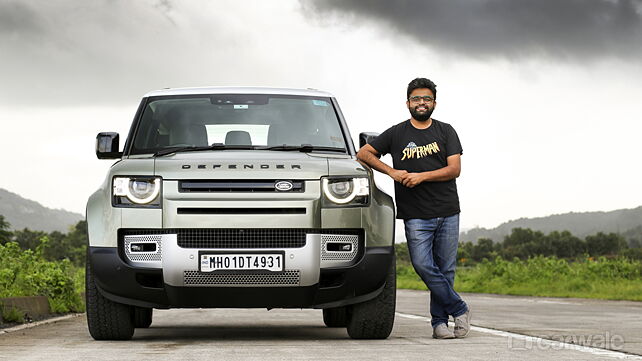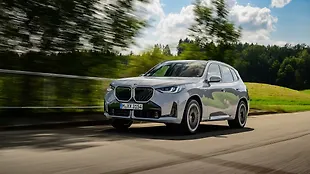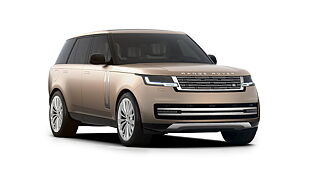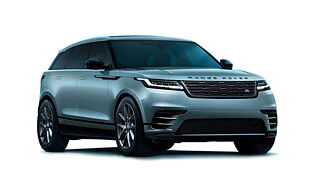Why would I buy it?
- Unusual road presence
- Go anywhere ability
- Ride quality
Why would I avoid it?
- Doesn’t offer much in terms of novelty tech
- Limited usability compared to the Defender 110
What is it?
8 / 10
Let me begin by telling you what the new Defender 90 isn’t. It’s unlike anything else on the road nowadays – it’s not a sumptuous, cutting-edge luxo-barge for the elite, and it’s certainly not a humdrum A-to-B vehicle. What it actually is, is an icon reimagined for the 21st century. A genuine albeit properly sophisticated descendent of the original Land Rover Defender 90, the plucky Brit that made its name in the world of off-roading in the 80s and the 90s.

To my eye, the new Defender 90 is an icon already. It’s exactly how a modern take on a classic should be – a simple yet purposeful design that pays homage to the original without being ostentatious or loud. One good look at it, and you know it’s rugged, and you know it wants to go off-road and show you what it can do.

The original Defender 90 is a stubby little thing, and this new one is stubbier still. It’s so high off the ground (in the off-road ride height setting, that is) and so short that it’s almost comical. But the thing is, Land Rover has put in some extra work to make this new model give the same vibe as the original while simultaneously making it off-road friendly.

For starters, some items like the battery and cooling circuits have been relocated to make the front/rear overhangs ultra-short and improve approach and departure angles to 38 and 40 degrees, respectively. The breakover angle of 31 degrees is also pretty solid, and if you ask me, it will take some heavy off-roading to even come close to scraping the underside of the Defender 90. More on that later. Let’s see what it’s like inside.
Is the cabin any good?
8 / 10

The Defender’s cabin is another design highlight that justifiably marries old-world charm with new-age tech. So it’s classically rugged looking with exposed screw heads on the door pads, rubber-like coating on the dash and even some body-coloured metal bits. But in the same space, you also get good quality plastics all around, soft-touch materials and a massive, fully digital instrument cluster behind the steering wheel. The old Defender was never particularly focused on comfort and luxury, but this all-new generation model has made a considerable stride in making the cabin fit for the price.

The Defender 90 has two doors only, so naturally, it may not be the ideal choice for daily-driven duties. Still, there is a surprising amount of room in the second row – there are acres of headroom and legroom despite the shorter wheelbase. All in all, the second row is actually a delightful place to be in simply because of the sheer amount of glass that envelopes it. So you have huge side windows which let in a lot of light, and then there are safari windowpanes on the roof, which look super cool. The latter also feature on the 110 four-door model, but they are in the boot area.

The Defender 90 lacks high-end novelty features like gesture control, massaging seats and the likes but overall, it does well when it comes to equipment. There’s a panoramic sunroof, four-zone climate control, surround view camera, six airbags, a nice sounding Meridian audio system and a digital inside rearview mirror. There’s also a centre console storage between the front seats that works as a cooler.

Is it nice to drive?
8 / 10

For what it is, the Defender 90 is nice to drive, but the likeability factor isn’t quite innate. Let me explain. So it’s a heavy, off-roader with a super rugged monocoque construction and a stiff aluminium body, all based on Land Rover’s legendary 4x4 foundations. But the engine powering this P300 version is a two-litre, four-cylinder petrol engine making 300bhp and 400Nm of torque. Doesn’t seem like a lot, right? Wrong.

The fact that it’s a two-litre engine hauling all of this obvious bulk would trick one into thinking that the performance might be dull though the reality is far from that. Progress at everyday speeds feels effortless, whether cruising on the city streets or quick sprints between the lights. Another really likeable thing about the Defender 90 is its automatic gearbox which is smooth and seamless for the most part. It’s not the quickest to react when you stomp on the throttle pedal, but it wouldn’t give you a reason to complain, either. I also like how refined the engine is at normal RPMs but is snarly and properly loud when you go full throttle.

The ride on the Defender 90 is fantastic despite the enormous wheels. It’s well damped and absorbent. Driving around on our monsoon-battered roads, the Defender 90 dealt with the unexpected potholes and roughness with ease. It’s just that you can hear some of the sharp edges filter into the cabin with a thud. The steering isn’t incredibly precise, but it is light enough, and even though you are always conscious of the tall stance as you drive along, overall, the Defender 90 is really nice to drive thanks to the eager engine, plush ride and the sort of agility that you get from its short wheelbase.

We didn’t get a chance to take the Defender on an off-road course this time, though we are looking forward to having it again for the annual CarWale Off-Road Day. So besides 4x4 with locking differentials, off-road driving modes, and air suspension with adjustable ride height, the Defender 90 also gets Land Rover’s very capable terrain response system, ground view camera and a wading depth of 900mm, which is incredible.

Should you buy it?
8 / 10

As a super cool-looking weekend toy that’s also absurdly capable? Totally. As an everyday SUV to ferry you in comfort and maybe even run your errands? It will be a difficult pick. I am not sure one can live with the Defender 90 on a daily basis, but then again, there is a simple solution to that, and it comes from Land Rover themselves. The four-door Defender 110. Albeit less cool, the latter would definitely be a more usable daily driven vehicle.
Pictures by Kaustubh Gandhi



































